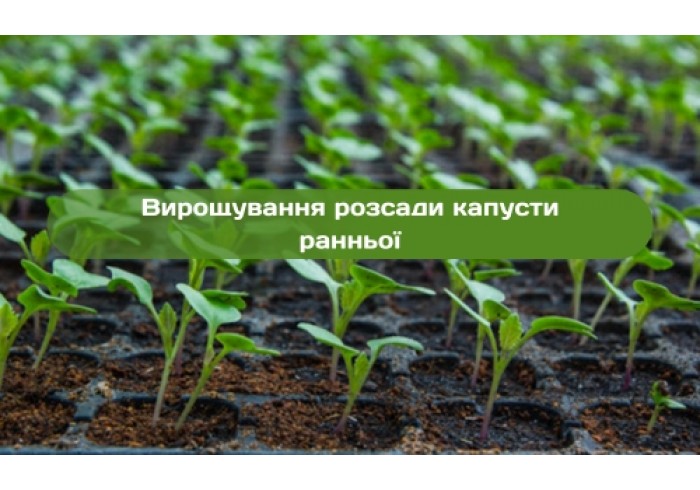Growing early cabbage seedlings
Early cabbage is highly valuable for both producers and consumers. It fills the market gap before the main summer vegetables appear and provides high profits for farmers at a time when prices for fresh vegetables are significantly higher than during the main season.
For consumers, early cabbage is a source of fresh vitamins and minerals after the winter season, when the assortment of fresh vegetables is limited. It is rich in fiber, vitamins C, K, and B group, making it an important component of a healthy diet.
Seedling Growing Methods
- In open ground – seeds are sown directly into garden beds. Strongly dependent on weather conditions. High susceptibility to pests and diseases. No temperature control. Requires weeding.
- In greenhouses or hotbeds – requires constant microclimate control (heating, ventilation). Lighting costs. Diseases spread quickly in closed environments.
- Hydroponics – grown without soil in nutrient solutions. Requires specialized knowledge. Constant monitoring of pH and nutrient levels. Difficulties with transplanting into open ground.
- In various containers:
Seedling trays (cell trays). Allow for compact placement of many plants in a small area. Easy to care for and transport. Saves potting mix. Moisture control. Uniform growth due to equal nutrient distribution. No overcrowding. Reduced risk of disease spread. No root damage during transplanting (removed with root ball), aiding faster plant adaptation. The price of trays quickly pays off thanks to their durability and long-term use.
Pots. Take up a lot of space. Require large amounts of soil. Difficult to transport. Risk of root damage when removing the plant.
Peat pots. Eco-friendly, decompose in the soil. Allow good airflow and water permeability. No root damage during transplanting. Expensive. Dry out quickly.
Peat pellets. Eco-friendly. Expensive. Dry out quickly, require constant moisture control. Susceptible to fungal diseases if overwatered. Limited space for root development. Recommended for plants sensitive to transplanting.
Recommended characteristics for cabbage seedling trays:
- Cell volume: From 25 to 150 cm³, with the optimal size being 100–150 cm³. These trays are spacious enough for root development yet compact.
- Depth: 55–80 mm. Deeper trays promote healthy taproot growth and help prevent substrate from drying out — ideal for moisture-loving crops.
- Number of cells: For large farms — 96 to 160 cells; for home use — 40 to 50 cells are sufficient.
- Cell shape: Pyramidal is best — it supports root development and makes it easier to remove seedlings during transplanting.
It is recommended to purchase seedling trays with drip trays, as cabbage is very sensitive to soil moisture levels.
Optimal Conditions for Growing Early Cabbage Seedlings
- Temperature: Daytime 16–18°C, nighttime 8–10°C.
- Light: 12–14 hours per day. Supplemental lighting is needed if natural light is insufficient.
- Air humidity: 65–70%.
- Soil moisture: 70–80%.
- Substrate: Light, water-permeable, nutrient-rich, pH 6.0–6.8.
- Watering: Thorough but infrequent (once a week), followed by ventilation to avoid overwatering and prevent damping-off disease.
- Fertilizing: Use phosphorus, potassium, and calcium fertilizer when seedlings emerge. After the first true leaf, apply NPK and micronutrients.
- Hardening: 7–10 days before transplanting, gradually lower the temperature to 12–15°C.
Sowing time depends on the intended harvest or sale period:
- For the earliest harvest (late May – early June), sow seeds in February.
- Sowing in March will produce a harvest ready for June–July.
- For a late summer harvest (July–August), sow seeds in April.
Seedlings should be transplanted to open ground at 30–35 days old, once they have 4–5 true leaves. At this stage, plants establish well, adapt quickly, and resume growth in the shortest time possible.
For early transplanting, garden beds should be covered with white agrotextile to protect from frost. The fabric density depends on your region’s climate. Mulching with black agrofiber will help suppress weed growth.
Common Seedling Problems and How to Solve Them
It’s not enough to simply buy trays and sow seeds — proper care is essential to avoid problems.
| Problem | Cause | Solution |
|---|---|---|
| Seedling elongation | insufficient light high temperature overcrowding |
add supplemental lighting gradually reduce temperature to 12–15°C thin or transplant on time |
| Damping-off disease | high humidity poor ventilation infected substrate |
use fungicides and ventilate properly sterilize soil before sowing |
| Nutrient deficiency | lack of fertilizer application | timely fertilization |
| Seedling damage | cabbage fly mold |
preventative insecticide treatments use physical barriers |
| Transplant shock | root damage sudden change in conditions |
carefully remove seedlings gradually acclimate plants |
With proper care, early cabbage seedlings will quickly take root in open soil and provide an early and high-quality harvest.



